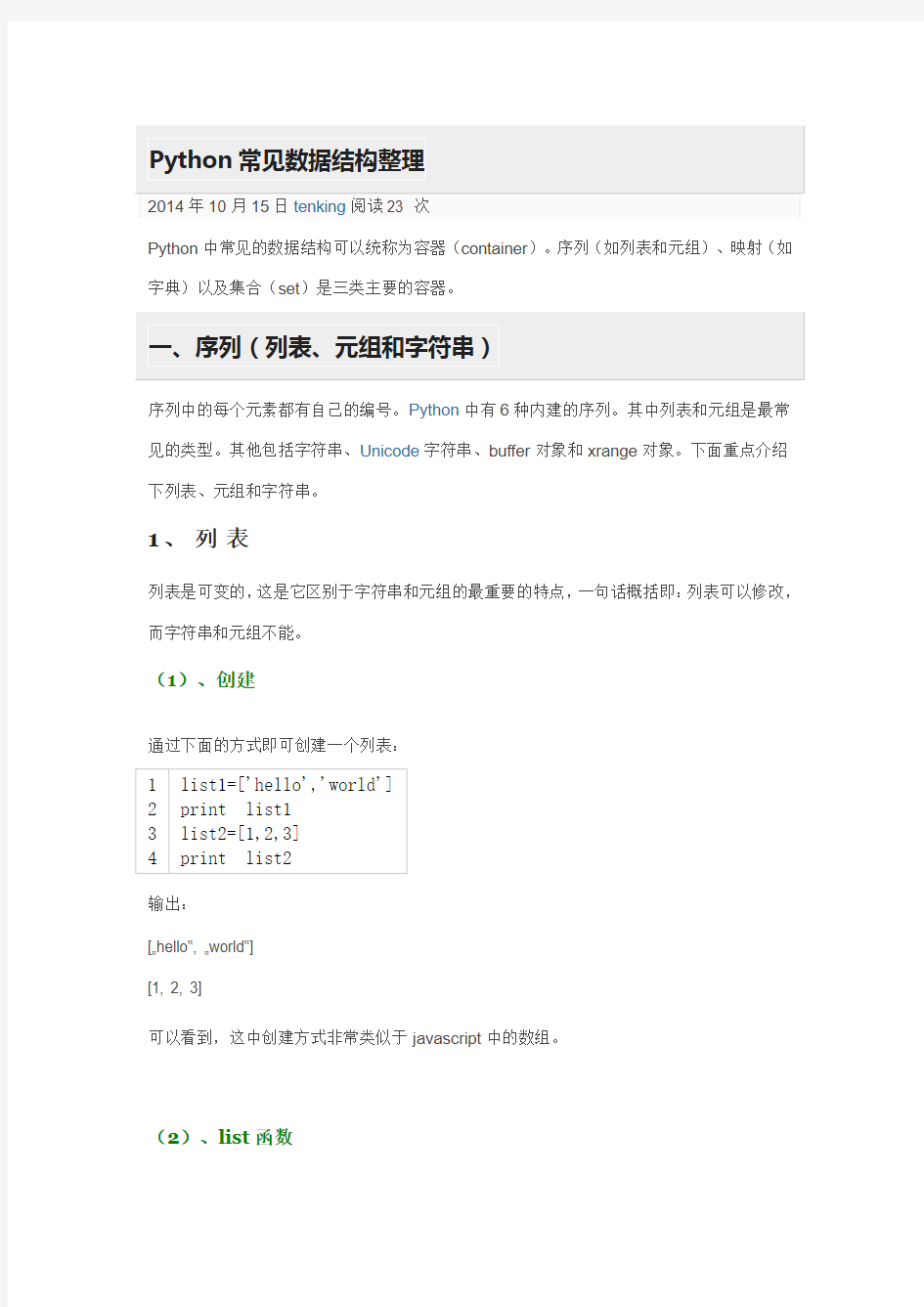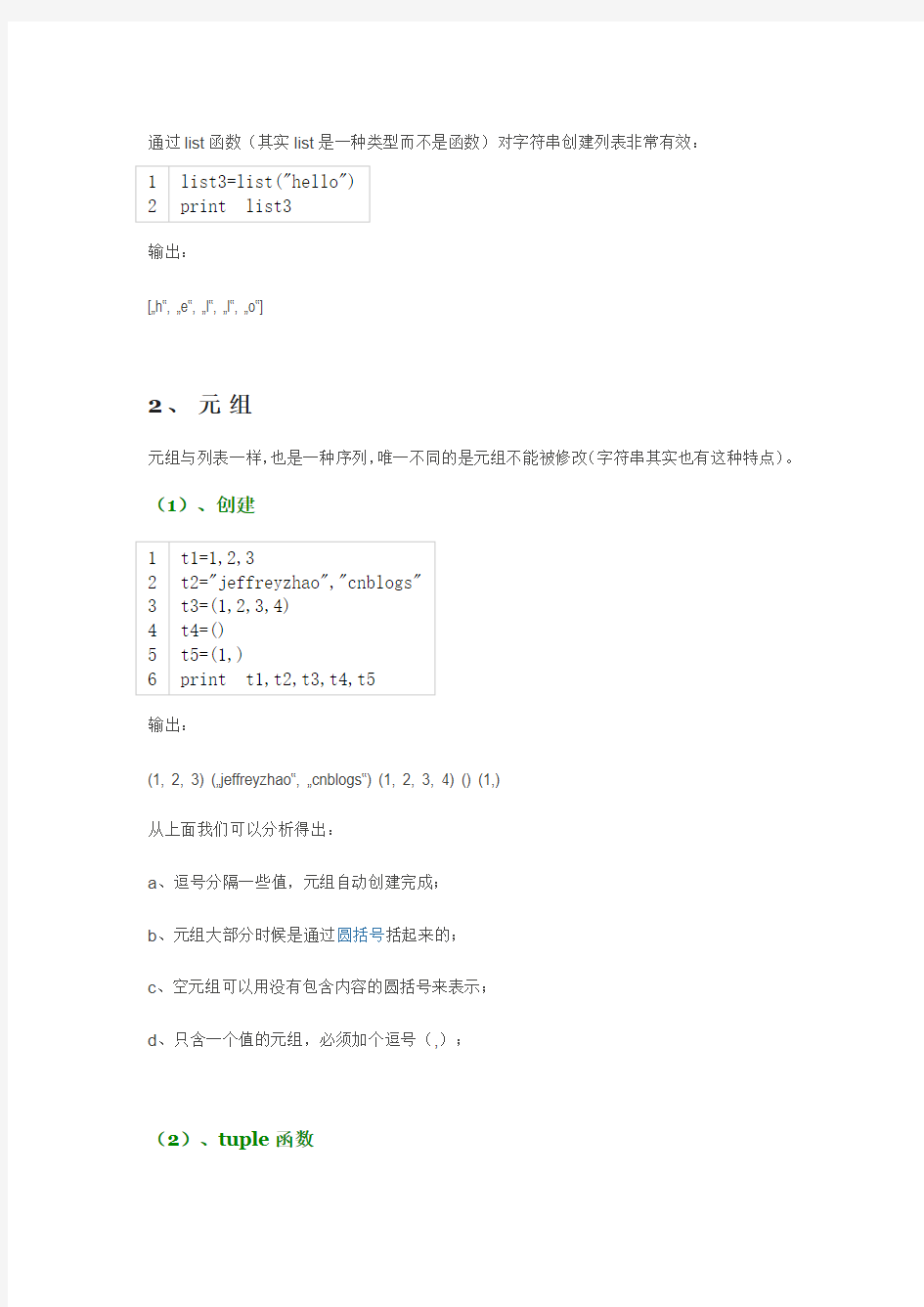Python常见数据结构整理


Python常见数据结构整理
2014年10月15日tenking阅读23 次
Python中常见的数据结构可以统称为容器(container)。序列(如列表和元组)、映射(如字典)以及集合(set)是三类主要的容器。
一、序列(列表、元组和字符串)
序列中的每个元素都有自己的编号。Python中有6种内建的序列。其中列表和元组是最常见的类型。其他包括字符串、Unicode字符串、buffer对象和xrange对象。下面重点介绍下列表、元组和字符串。
1、列表
列表是可变的,这是它区别于字符串和元组的最重要的特点,一句话概括即:列表可以修改,而字符串和元组不能。
(1)、创建
通过下面的方式即可创建一个列表:
1 2 3 4list1=['hello','world'] print list1
list2=[1,2,3]
print list2
输出:
[…hello?, …world?]
[1, 2, 3]
可以看到,这中创建方式非常类似于javascript中的数组。(2)、list函数
通过list函数(其实list是一种类型而不是函数)对字符串创建列表非常有效:
1 2list3=list("hello") print list3
输出:
[…h?, …e?, …l?, …l?, …o?]
2、元组
元组与列表一样,也是一种序列,唯一不同的是元组不能被修改(字符串其实也有这种特点)。(1)、创建
1 2 3 4 5 6t1=1,2,3
t2="jeffreyzhao","cnblogs" t3=(1,2,3,4)
t4=()
t5=(1,)
print t1,t2,t3,t4,t5
输出:
(1, 2, 3) (…jeffreyzhao?, …cnblogs?) (1, 2, 3, 4) () (1,)从上面我们可以分析得出:
a、逗号分隔一些值,元组自动创建完成;
b、元组大部分时候是通过圆括号括起来的;
c、空元组可以用没有包含内容的圆括号来表示;
d、只含一个值的元组,必须加个逗号(,);(2)、tuple函数
tuple函数和序列的list函数几乎一样:以一个序列(注意是序列)作为参数并把它转换为元组。如果参数就算元组,那么该参数就会原样返回:
1 2 3 4 5 6 7 8t1=tuple([1,2,3]) t2=tuple("jeff") t3=tuple((1,2,3)) print t1
print t2
print t3
t4=tuple(123) print t45
输出:
(1, 2, 3)
(…j?, …e?, …f?, …f?)
(1, 2, 3)
Traceback (most recent call last):
File “F:\Python\test.py”, line 7, in
TypeError: …int? object is not iterable
3、字符串
(1)创建
1 2 3 4 5str1='Hello world' print str1
print str1[0]
for c in str1:
print c
输出:Hello world H
H
e
l
l
o
w
o
r
l
d
(2)格式化
字符串格式化使用字符串格式化操作符即百分号%来实现。
1 2str1='Hello,%s' % 'world.' print str1
格式化操作符的右操作数可以是任何东西,如果是元组或者映射类型(如字典),那么字符串格式化将会有所不同。
1 2 3 4 5 6strs=('Hello','world')#元组
str1='%s,%s' % strs
print str1
d={'h':'Hello','w':'World'}#字典str1='%(h)s,%(w)s' % d
print str1
输出:Hello,world Hello,World
注意:如果需要转换的元组作为转换表达式的一部分存在,那么必须将它用圆括号括起来:
1 2str1='%s,%s' % 'Hello','world' print str1
输出:
Traceback (most recent call last):
File “F:\Python\tes t.py”, line 2, in
str1=?%s,%s? % …Hello?,?world?
TypeError: not enough arguments for format string
如果需要输出%这个特殊字符,毫无疑问,我们会想到转义,但是Python中正确的处理方式如下:
1 2str1='%s%%' % 100 print str1
输出:100%
对数字进行格式化处理,通常需要控制输出的宽度和精度:
1 2 3 4 5 6 7from math import pi
str1='%.2f' % pi#精度2
print str1
str1='%10f' % pi#字段宽10
print str1
str1='%10.2f' % pi#字段宽10,精度2 print str1
输出:
3.14
3.141593
3.14
字符串格式化还包含很多其他丰富的转换类型,可参考官方文档。
Python中在string模块还提供另外一种格式化值的方法:模板字符串。它的工作方式类似于很多UNIX Shell里的变量替换,如下所示:
1 2 3 4from string import Template
str1=Template('$x,$y!')
str1=str1.substitute(x='Hello',y='world') print str1
输出:
Hello,world!
如果替换字段是单词的一部分,那么参数名称就必须用括号括起来,从而准确指明结尾:
1 2 3 4from string import Template str1=Template('Hello,w${x}d!') str1=str1.substitute(x='orl') print str1
输出:
Hello,world!
如要输出$符,可以使用$$输出:
1 2 3 4from string import Template str1=Template('$x$$')
str1=str1.substitute(x='100') print str1
输出:100$
除了关键字参数之外,模板字符串还可以使用字典变量提供键值对进行格式化:
1 2 3 4 5from string import Template d={'h':'Hello','w':'world'}
str1=Template('$h,$w!')
str1=str1.substitute(d)
print str1
输出:Hello,world!
除了格式化之外,Python字符串还内置了很多实用方法,可参考官方文档,这里不再列举。
4、通用序列操作(方法)
从列表、元组以及字符串可以“抽象”出序列的一些公共通用方法(不是你想像中的CRUD),这些操作包括:索引(indexing)、分片(sliceing)、加(adding)、乘(multiplying)以及检查某个元素是否属于序列的成员。除此之外,还有计算序列长度、最大最小元素等内置函数。
(1)索引
1 2 3 4 5 6str1='Hello' nums=[1,2,3,4] t1=(123,234,345) print str1[0] print nums[1] print t1[2]
输出
H
2
345
索引从0(从左向右)开始,所有序列可通过这种方式进行索引。神奇的是,索引可以从最后一个位置(从右向左)开始,编号是-1:
1 2 3 4 5 6str1='Hello' nums=[1,2,3,4] t1=(123,234,345) print str1[-1] print nums[-2] print t1[-3]
输出:
o
3
123
(2)分片
分片操作用来访问一定范围内的元素。分片通过冒号相隔的两个索引来实现:
1 2 3 4 5 6 7 8nums=range(10)
print nums
print nums[1:5]
print nums[6:10]
print nums[1:]
print nums[-3:-1]
print nums[-3:]#包括序列结尾的元素,置空最后一个索引print nums[:]#复制整个序列
输出:
[0, 1, 2, 3, 4, 5, 6, 7, 8, 9] [1, 2, 3, 4]
[6, 7, 8, 9]
[1, 2, 3, 4, 5, 6, 7, 8, 9] [7, 8]
[7, 8, 9]
不同的步长,有不同的输出:
1 2 3 4 5 6 7 8nums=range(10)
print nums
print nums[0:10] #默认步长为1 等价于nums[1:5:1] printnums[0:10:2] #步长为2
print nums[0:10:3] #步长为3
##print nums[0:10:0] #步长为0
printnums[0:10:-2] #步长为-2
输出:
[0, 1, 2, 3, 4, 5, 6, 7, 8, 9] [0, 1, 2, 3, 4, 5, 6, 7, 8, 9] [0, 2, 4, 6, 8]
[0, 3, 6, 9]
[]
(3)序列相加
1 2 3 4 5 6 7str1='Hello'
str2=' world' print str1+str2 num1=[1,2,3] num2=[2,3,4] print num1+num2 print str1+num1
输出:
Hello world
[1, 2, 3, 2, 3, 4]
Traceback (most recent call last):
File “F:\Python\test.py”, line 7, in
print str1+num1
TypeError: cannot concatenate …str? and …list? objects (4)乘法
1 2 3 4 5 6print [None]*10 str1='Hello' print str1*2 num1=[1,2]
print num1*2 print str1*num1
输出:
[None, None, None, None, None, None, None, None, None, None]
HelloHello
[1, 2, 1, 2]
Traceback (most recent call last):
File “F:\Python\test.py”, line 5, in
print str1*num1
TypeErr or: can?t multiply sequence by non-int of type …list?
(5)成员资格
in运算符会用来检查一个对象是否为某个序列(或者其他类型)的成员(即元素):
1 2 3 4 5str1='Hello'
print 'h' in str1 print 'H' in str1 num1=[1,2]
print 1 in num1
输出:
False
True
True
(6)长度、最大最小值
通过内建函数len、max和min可以返回序列中所包含元素的数量、最大和最小元素。
1 2 3 4 5 6 7 8str1='Hello'
print len(str1) print max(str1) print min(str1) num1=[1,2,1,4,123] print len(num1) print max(num1) print min(num1)
输出:
5
o
H
5
123
1
二、映射(字典)
映射中的每个元素都有一个名字,如你所知,这个名字专业的名称叫键。字典(也叫散列表)是Python中唯一内建的映射类型。
1、键类型
字典的键可以是数字、字符串或者是元组,键必须唯一。在Python中,数字、字符串和元组都被设计成不可变类型,而常见的列表以及集合(set)都是可变的,所以列表和集合不能作为字典的键。键可以为任何不可变类型,这正是Python中的字典最强大的地方。
1 2 3 4 5 6 7 8list1=["hello,world"] set1=set([123])
d={}
d[1]=1
print d
d[list1]="Hello world." d[set1]=123
print d
输出:
{1: 1}
Traceback (most recent call last):
File “F:\Python\test.py”, line 6, in
d[list1]=”Hello world.”
TypeError: unhashable type: …list?
2、自动添加
即使键在字典中并不存在,也可以为它分配一个值,这样字典就会建立新的项。
3、成员资格
表达式item in d(d为字典)查找的是键(containskey),而不是值(containsvalue)。
Python字典强大之处还包括内置了很多常用操作方法,可参考官方文档,这里不再列举。思考:根据我们使用强类型语言的经验,比如C#和Java,我们肯定会问Python中的字典是线程安全的吗?
三、集合
集合(Set)在Python 2.3引入,通常使用较新版Python可直接创建,如下所示:
strs=set(['jeff','wong','cnblogs'])
nums=set(range(10))
看上去,集合就是由序列(或者其他可迭代的对象)构建的。集合的几个重要特点和方法如下:
1、副本是被忽略的
集合主要用于检查成员资格,因此副本是被忽略的,如下示例所示,输出的集合内容是一样的。
1 2 3 4 5set1=set([0,1,2,3,0,1,2,3,4,5]) print set1
set2=set([0,1,2,3,4,5])
print set2
输出如下:
set([0, 1, 2, 3, 4, 5])
set([0, 1, 2, 3, 4, 5])
2、集合元素的顺序是随意的
这一点和字典非常像,可以简单理解集合为没有value的字典。
1 2strs=set(['jeff','wong','cnblogs']) print strs
输出如下:
set([…wong?, …cnblogs?, …jeff?])
3、集合常用方法
a、交集union
1 2 3 4 5 6set1=set([1,2,3])
set2=set([2,3,4])
set3=set1.union(set2) print set1
print set2
print set3
输出:
set([1, 2, 3])
set([2, 3, 4])
set([1, 2, 3, 4])
union操作返回两个集合的并集,不改变原有集合。使用按位与(OR)运算符“|”可以得到一样的结果:
1 2 3 4 5 6set1=set([1,2,3]) set2=set([2,3,4]) set3=set1|set2 print set1
print set2
print set3
输出和上面union操作一模一样的结果。
其他常见操作包括&(交集),<=,>=,-,copy()等等,这里不再列举。
1 2 3 4 5 6 7 8 9 10set1=set([1,2,3])
set2=set([2,3,4])
set3=set1&set2
print set1
print set2
print set3
print set3.issubset(set1) set4=set1.copy()
print set4
print set4 is set1
输出如下:set([1, 2, 3]) set([2, 3, 4]) set([2, 3]) True
set([1, 2, 3]) False
b、add和remove
和序列添加和移除的方法非常类似,可参考官方文档:
1 2 3 4 5 6 7 8 9set1=set([1])
print set1
set1.add(2)
print set1
set1.remove(2)
print set1
print set1
print 29 in set1
set1.remove(29)#移除不存在的项
输出:
set([1])
set([1, 2])
set([1])
set([1])
False
Traceback (most recent call last):
File “F:\Python\test.py”, line 9, in
set1.remove(29) #移除不存在的项
KeyError: 29
4、f r o z e n s e t
集合是可变的,所以不能用做字典的键。集合本身只能包含不可变值,所以也就不能包含其他集合:
1 2set1=set([1]) set2=set([2])
3set1.add(set2)
输出如下:
Traceback (most recent call last):
File “F:\Python\test.py”, line 3, in
set1.add(set2)
TypeError: unhashable type: …set?
可以使用frozenset类型用于代表不可变(可散列)的集合:
1 2 3 4set1=set([1])
set2=set([2])
set1.add(frozenset(set2)) print set1
输出:
set([1, frozenset([2])])
参考:
https://www.360docs.net/doc/233479056.html,/
作者:Jeff Wong
出处:https://www.360docs.net/doc/233479056.html,/jeffwongishandsome/archive/2012/08/05/2623660.html
